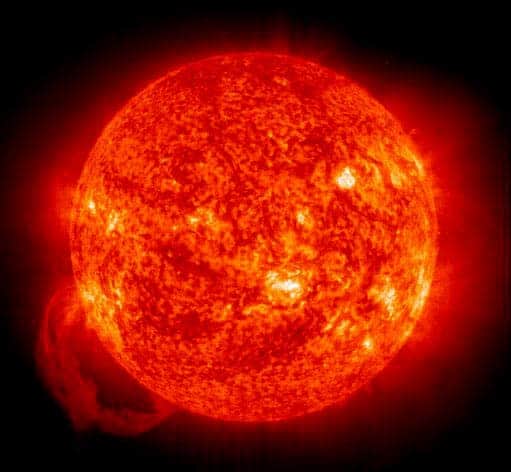
Physicists have so far failed to find direct evidence for the existence of dark matter – the non-luminous substance believed to make up some 23% of the mass-energy content of the universe – at least to the satisfaction of everyone working in the field. But now physicists in Portugal and the UK suggest that such evidence could be found in precision measurements of the neutrinos given off by the Sun.
Although astronomical observations provide indirect evidence for dark matter, experiments on Earth have yet to secure direct and definitive proof that this form of matter exists. Ilidio Lopes of the Technical University of Lisbon and the University of Évora in Portugal together Joseph Silk of the University of Oxford argue that proof might lurk within the Sun. This is because the huge gravitational field of our star is expected to suck in weakly interacting massive particles (WIMPs), which are a leading candidate for dark matter.
Once trapped inside the core of the Sun, WIMPs should collide with protons, gain energy slightly and gradually remove heat outwards from the centre of the star. As such, the radial distribution of temperature across the Sun would be different in the absence or presence of dark matter.
Taking the Sun’s temperature
The pair’s plan for identifying this altered temperature distribution relies on detecting neutrinos that are generated by a number of different fusion reactions within the Sun. The crucial point is that different reactions take place at different distances from the centre of the Sun – the reaction producing boron-8, for example, takes place at just 4% of the solar radius whereas that involving the production of nitrogen-13 occurs at 16% of the solar radius. Since the strength of these reactions depends strongly on temperature, and this dependence varies from reaction to reaction, the presence of solar dark matter would lead to a well defined change in the relative fluxes of the neutrinos produced in the different reactions. The detection of dark matter would therefore fall to experiments set up to measure neutrino fluxes, with the fluxes from the different fusion reactions distinguishable on the basis of the distinctive energy spectra of the neutrinos in each case.
The two physicists used computer simulations to calculate, given certain assumptions about the properties of WIMPs – including their mass, strength of interaction with baryons, and likelihood of mutual annihilation – that the presence of dark matter could increase the flux of neutrinos produced in the boron-8 reactions by as much as 30% and would decrease the flux from the basic proton–proton reaction by around 2%. These results back up a similar analysis carried out earlier this year by Marco Taoso of the University of Valencia in Spain and colleagues, who used slightly different theoretical assumptions and computer codes.
Lopes and Silk say that if they are lucky and WIMPs do have the characteristics assumed in their analysis then the effect of dark matter on the strength of the relative neutrino fluxes would be striking enough to permit a direct detection of dark matter in upgrades to existing solar neutrino detectors. But they claim that their approach could in any case reduce the number of candidate dark-matter particles put forward by particle physicists and cosmologists.
Nothing in the data yet
Gianpaolo Bellini, spokesperson of the Borexino solar-neutrino detector at the Gran Sasso laboratory in Italy, points out that measurements by Borexino and other similar experiments are consistent with the current standard solar model, which does not take into account possible contributions from dark matter. He says that there is a significant margin of error on this agreement between measurements and model, potentially leaving room for some variation in neutrino flux along the lines laid out by Lopes and Silk. But he says he would need to see a more detailed presentation of their argument before really judging the feasibility of their approach.
Dave Wark of Imperial College in London describes the research as “extremely interesting” but agrees with Bellini that more information is needed to make a detailed critique. In particular, he says that further work is required to establish that any apparent solar cooling is due to dark matter rather than to misunderstandings of the Sun’s internal properties. He adds that changes to the parameters governing neutrino oscillation might also mimic or hide the effects of dark matter.
The work is described published online in Sciencexpress.



